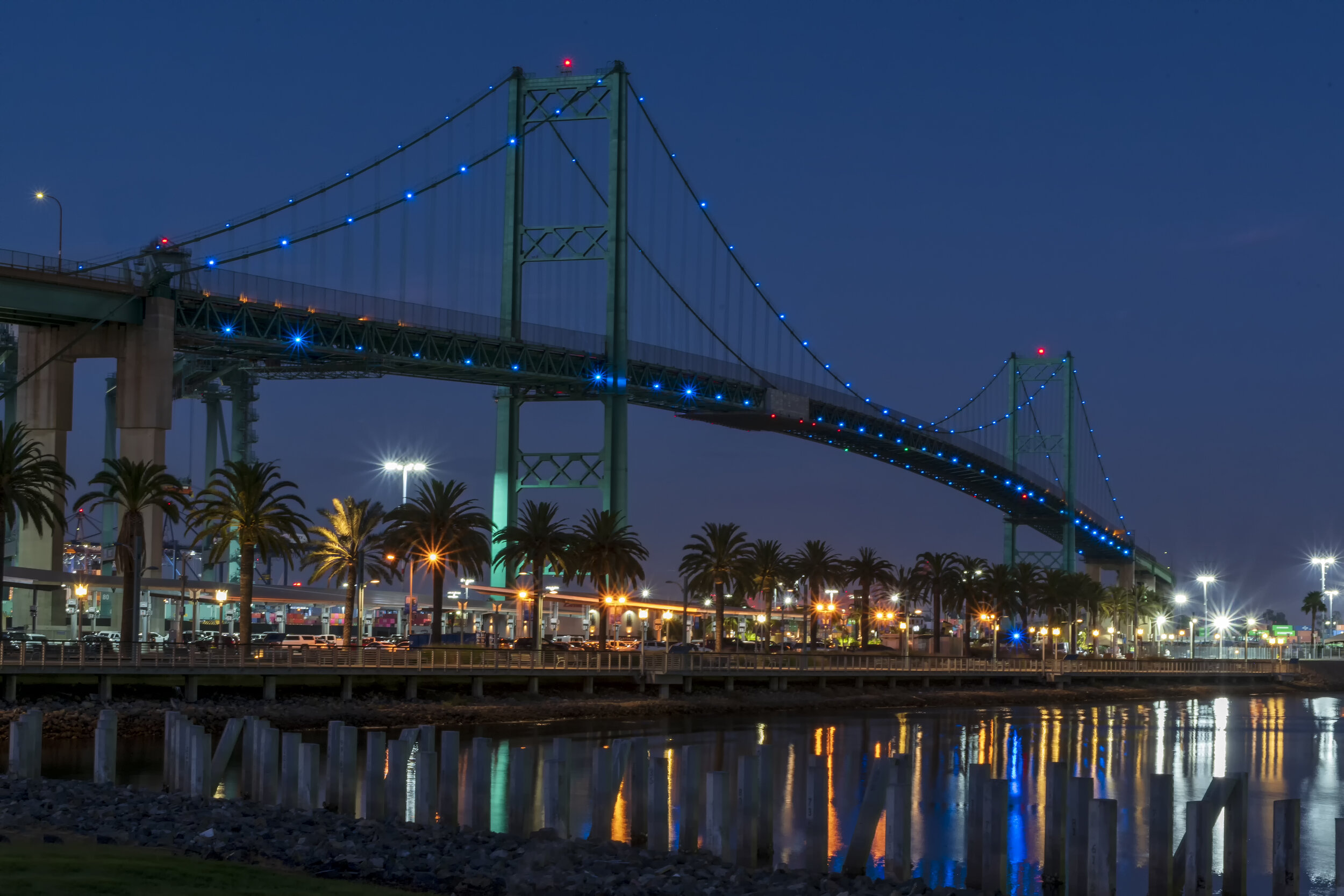Vincent Thomas Bridge- Spanning Los Angeles’ Past and Future By Steve Tabor
Vincent Thomas Bridge- Spanning Los Angeles’ Past and Future
By Steve Tabor
The City of San Pedro and Terminal Island are forever linked in Los Angeles’ maritime history. However, it was not until 1870 when private ferry service provided service between the two locations. In 1941 the Municipal Ferry Service provided regularly scheduled services for passengers and vehicles between Terminal Island and San Pedro aboard its double decked ferries, “Islander” and “Ace”. In November 1963, ferry services were ceased when the Vincent Thomas Bridge was opened.
Thoughts of building a bridge between Terminal Island and San Pedro were discussed as early as 1920, but it was not until 1958 when the California legislature approved a bill funding the construction of what was jokingly called “The Bridge to Nowhere.”
The suspension bridge design called for the entire structure’s foundation to be formed from 990 steel poles, known as piles, that were hammered into the soil until they reached a layer of hard compacted soil or rock. Each pile supports up to 145 tons. By the time the project was completed, construction crews used 92,000 tons of Portland cement, 13,000 tons of lightweight concrete, 14,100 tons of steel and 1,270 of steel suspension cable. The bridge stretches a total length of 6,050 feet with the main suspension length of 1,500 feet is equally divided into three 500 ft sections between its two towers supporting 19 suspension cables. Each cable consists of 212 steel wires. This was the first welded suspension bridge built in the U.S. and can withstand 90 mph winds. The entire construction bill totaled $21 million.
In 1968, “The Bridge to Nowhere” designation had to be retired by connecting the Terminal Island Bridge, State Route (SR) 47, the Port of Long Beach, the Port of Los Angeles, the Harbor Freeway, and railroad freight lines. Many City of Los Angeles and Port of Los Angeles officials credit the Bridge for the Port’s success in playing a major role in the container ship era.
Originally, a $0.25 toll was assessed for each westbound and eastbound vehicle. In 1983, a $0.50 toll was assessed to westbound bound traffic only. The toll charge was discontinued in 2000. The Toll Plaza serves as a field facility for the California Highway Patrol.
In celebration of its 25th anniversary in 1988, a fundraiser project provided $170,000 to install decorative lights on the bridge’s main cables. In 2005, solar panels were installed, and the original lights were replaced by 160 20-watt blue LED lights. During the day, the solar panels supplemental Los Angeles’ electrical power grid. At night the panels help to light the 160 decorative bulbs from dusk until midnight.
As plans were made to open the bridge, the California legislature passed special legislation to name the bridge after California Assembly Member, Vincent Thomas. Assembly Member Mr. Thomas began his term in the California Assembly in 1940 representing the City of San Pedro and surrounding area. At the time of the legislation, he was the longest serving member of the Assembly and had supported over 16 different pieces of legislation supporting the bridge’s construction. Assembly Member Thomas left the Assembly after serving 19 Assembly terms for a total of 38 years in 1978.
Specifics about the Bridge:
The bridge is the 4th longest suspension in California and the 76th longest bridge in the world.
The towers are 365 ft tall.
The bottom of the bridge is 185 ft above the water.
Approximately 32,000 vehicles cross the bridge each weekday.
Painting the bridge requires 500 gallons of primer and 1,000 gallons of green zinc-based paint.
The bridge is designated as the official landmark for welcoming visitors to the City of Los Angeles.
Sources:
Port of Los Angeles
San Pedro Bay Historical Society
San Pedro News Pilot
Associated Press
Vincent Thomas Bridge- A Vital Link by C. MacDonald
Wikipedia
Steve Tabor Bio
This South Bay native’s photographic journey began after receiving his first 35 mm film camera upon earning his Bachelor of Arts degree. Steve began with photographing coastal landscapes and marine life. As a classroom teacher he used photography to share the world and his experiences with his students. Steve has expanded his photographic talents to include portraits and group photography, special event photography as well as live performance and athletics. Steve serves as a volunteer ranger for the Catalina Island Conservancy and uses this opportunity to document the flora and fauna of the island’s interior as well as photograph special events and activities.
Watch for Steve Tabor Images on the worldwide web.





